Nuns in American Public Life
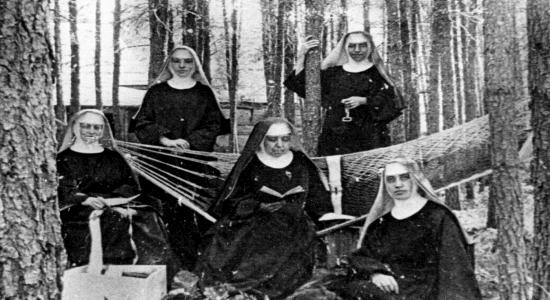
Sr. Mary Bendyna, Aquinas College
Sr. Mary Ann Hinsdale, IHM, Boston College
Margaret Thompson, Syracuse University
Moderated by Erik Owens
Date: October 18, 2012
Abstract
The historic and unprecedented contribution of American Catholic sisters to the areas of Catholic education, health care, and social services is one of broad consensus. As sisters embrace the Vatican II mandate to expand their role in public life, the consensus regarding their social justice service has been increasingly divided among the church. This panel will examine the contributions of Catholic sisters to American public life since Vatican II.
Speaker Bios
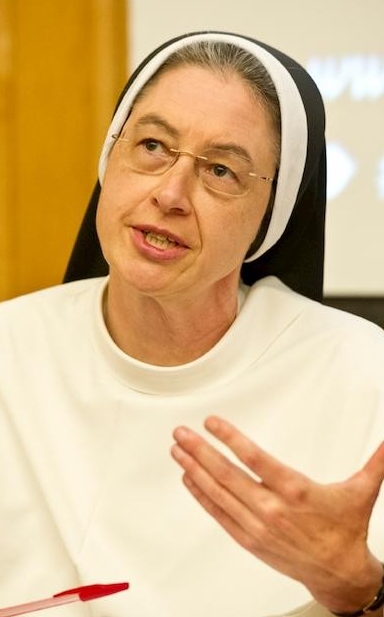
Sr. Mary Bendyna is the Director of Institutional Research and Accreditation at Aquinas College in Nashville, Tennessee. She is the former Executive Director and Senior Research Associate at the Center for Applied Research in the Apostolate (CARA) at Georgetown University, where she conducted numerous studies on ministry, education, faith formation, priesthood, and religious life. Her academic research examines religious beliefs and practices and their influence on political attitudes and behaviors, especially among Catholics in the United States. A former member of the Sisters of Mercy of the Americas, Sister Bendyna has been with the Dominican Sisters of St. Cecilia (the Nashville Dominicans) since 2010. She holds a B.A. in history and political science from Canisius College and an M.A. and Ph.D. in government from Georgetown University, and has also done graduate work in theology and education.
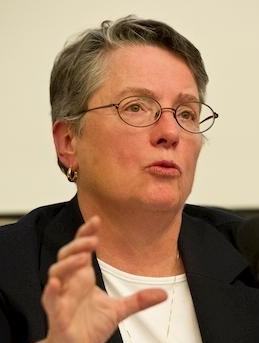
Sr. Mary Ann Hinsdale, IHM is associate professor of theology at Boston College. She is a member of the Sisters, Servants of the Immaculate Heart of Mary, a Roman Catholic religious order based in Monroe, Michigan. The most recent past president of the Catholic Theological Society of America, Sister Hinsdale specializes in ecclesiology, Christology, theological anthropology, and feminist theologies. Among her major publications are Women Shaping Theology;(2006);It Comes From the People: Community Development and Local Theology(1995), co-authored with Helen M. Lewis and S. Maxine Waller; and Women and Theology (1995), co-authored with Phyllis H. Kaminski. From 2000-2003 she served as director of the Institute for Religious Education and Pastoral Ministry (now a part of BC's School of Theology and Ministry); having come to BC after thirteen years at the College of the Holy Cross in Worcester, MA, where she chaired the religious studies department, taught theology and directed the women's studies program. She holds a B.A. from Marygrove College, an M.A. in Religious Education from the Catholic University of America, an S.T.L. from Regis College (Toronto), and a Ph.D. in systematic theology from the University of St. Michael's College (Toronto).
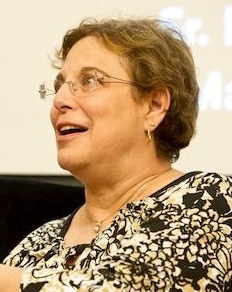
Margaret Susan Thompson is associate professor of history and political science at the Maxwell School of Citizenship and Public Affairs at Syracuse University, and Senior Research Associate at the Maxwell School's Campbell Public Affairs Institute. Her research focuses on the political and religious history of American women, especially the Americanization of Catholic women’s religious life. At work on a book entitled The Yoke of Grace: American Nuns and Social Change, 1808-1917, Professor Thompson has also published a wide array of articles and book chapters on the history of American Catholic women, lay and religious. She received her Ph.D. from the University of Wisconsin, Madison.
Event Photos
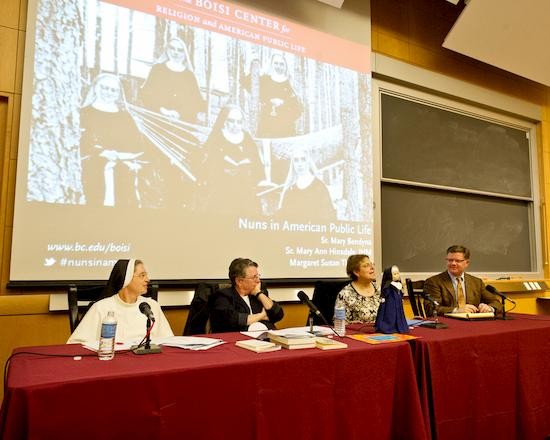
Sister Mary Bendyna, Sister Mary Ann Hinsdale, IHM and Margaret Thompson joined Boisi Center Associate Director Erik Owens for a panel on the role of nuns in American public life.

Sr. Mary Bendyna, Director of Institutional Research and Accreditation at Aquinas College in Nashville, Tennessee.

Margaret Susan Thompson, associate professor of history and political science at the Maxwell School of Citizenship and Public Affairs at Syracuse University, and Senior Research Associate at the Maxwell School's Campbell Public Affairs Institute.
Event Recap
Among the important outcomes of the Second Vatican Council (1962-1965) was a call for the world’s nuns to adapt their ministries to better serve the modern world. Over time many sisters in the United States increased their participation in social justice movements and political activism. In recent years, however, Pope Benedict XVI and some members of the Curia grew increasingly concerned that the modern sisters had strayed too far from their original mandates. In 2011, after a two-year investigation of the Leadership Conference of Women Religious (LCWR), an umbrella organization representing approximately eighty percent of America’s Catholic nuns, a Vatican report raised serious doctrinal concerns. To better understand the controversy and the historical role sisters have played in the American Church and broader society, the Boisi Center hosted a panel discussion with two prominent nuns and an historian of women religious on October 18.
Syracuse University historian Margaret Susan Thomson noted that Catholic sisters have always responded to social problems within the larger society, so their work is controversial by nature. During the Civil War, for example, nuns worked as nurses, defying political boundaries by treating soldiers from both the North and the South. Catholic sisters also provided the earliest form of health insurance in America, selling inexpensive tickets to miners and loggers that guaranteed medical care. These examples indicate the significance of public action and advocacy for social justice among Catholic nuns in America.
Boston College theology professor Sr. Mary Ann Hinsdale, I.H.M. added that nuns’ advocacy work can be a source of tension between the Vatican and American nuns. Case in point is the Vatican’s critical review of the LCWR, which was ostensibly simply aimed to assess declining numbers of women religious, but was felt by many sisters, said Sr. Hinsdale, as a mistrustful intrusion on their genuine efforts to put Catholic teaching into practice.
Finally, political scientist and Aquinas College administrator Sr. Mary Bendyna focused on the educational role of contemporary American nuns. Sr. Bendyna argued that many Catholics are unfamiliar with basic Church doctrine, leading them to prioritize their political ideologies ahead of their religious commitments. While affirming the crucial importance of other aspects of their mission, Sr. Bendyna argued that theological education and spiritual formation of the Catholic laity is central to the public witness of religious sisters today.
Of course the panelists discussed many more controversial and important topics that we cannot cover here. The lively exchanges among panelists and an audience with many nuns is worth viewing in its entirety, and we encourage you to do so at http://frontrow.bc.edu/program/nunsinamerica. (Most of the Boisi Center’s other events have video posted on their event pages as well.)
Read More
Further Reading
Brendyna, M., E. and Mary L. Gautier. "Recent Vocations to Religious Life: A Report for the National Religious Vocation Conference". Center for Applied Research in the Apostolate, Georgetown University. 2009.This report surveyed religious institutions and societies of apostolic life in the U.S. to gauge best practices and ascertain what specifically attracted interested men and women to religious life.
Brennan, Margaret. What Was There For Me Once: A Memoir. (Novalis Publishing, 2009). Margaret Brennan, IHM, chronicles her life as religious amidst the turmoil and excitement of the post-Vatical II era.
Briggs, Kenneth. Double Crossed: Uncovering the Catholic Church's Betrayal of American Nuns. (Doubleday Publishing, 2006). This book follows the struggle that American sisters have faced in their efforts to fully implement Vatican II changes.
Carey, Ann. Sisters in Crisis: The Tragic Unraveling of Women's Religious Communities. (My Sunday Visitor Publishing Division, 1997). Carey provides the perspective of those who have resisted the reforms put forth in Vatican II, directly targeting LCWR.
Chittister, Joan. The Way We Were: A Story of Conversion and Renewal. (Orbis Books, 2005). A personal account of the Benedictine Sisters of Erie, PA and their response to the updating of Vatican II.
Coburn, C., k., Martha Smith. Spirited Lives: How Nuns Shaped Catholic Culture and American Life, 1836-1920. (University of North Carolina Press, 1999). A scholarly research that follows the Sisters of St. Joseph of Carondolet and their institutional influence within the American historical context.
Confoy, Maryanne. Rediscovering Religious Life and Priesthood: Perfectae Caritatis, Optatam Totius, Presbyterorum Ordinis. (Paulist Press, 2008). This analysis uncovers the juridical factors underlying the debate on the public role of religious women.
Dries, Angelyn. "Living in Ambiguity: A Paradigm Shift Experienced by the Sister Formation Movement". The Catholic Historical Review, 79 (3). 1993. This article looks at the early movement of the Sister Formation Conference and its effort to establish a distinctive training role for sisters in light of the expanding role of laity.
Ewens, Mary. The Role of the Nun in Nineteenth Century America. (Arno Press, 1978). A historical account of the role of sisters in 19th century America.
Fialka, John. Sisters: Catholic Nuns and the Making of America. (St. Martin's Griffin, 2003). This book blends a historical account of American sisters with narratives that provide a wider look at the influential role and institutional contributions sisters have made in the building of American society.
Gaspary, Anita Marie. Witness to Integrity: The Crisis of the Immaculate Heart Community of California. (Liturgical Press, 2003). A personal account of Anita Gaspary, who was the Major Superior of the Immaculate Heart of Mary (IHM) of Los Angeles, during the post-Vatican days.
Kennelly, Karen. The Religious Formation: 1954-2004. (Religious Formation Conference, 2009). A historical account of the creation and development of the Sisters Formation Movement into the Religious Formation Conference.
Koblenschlag, Madonna. Between God and Caesar: Priest, Sisters and Political Office in the United States. (Paulist Press, 1985). An account of the public square question in the immediate post-Vatican II period, when Rev. Robert Drinan, SJ held a seat in the U.S. House of Representatives and Sr. Clare Dunn, CSJ, was a state representative in the Arizona legislature.
Koehlinger, Amy. The New Nuns: Racial Justice and Religious Reform in the 1960s. (Harvard University Press, 2007). A study on the racial apostolate of American sisters.
McNamara, Jo Ann Kay. Sisters in Arms: Catholic Nuns through Two Millennium. (Harvard University Press, 1996). A history of nuns that begins with the Roman Empire and ends around the late 1980s with American sisters.
Mulderry, Dara. "What Human Goodness Entails": An Intellectual History of United States Catholic Sisters, 1930-1980. (Brandeis University, 2006). A historical study of the intellectual thinking that guided the key reformers behind the Sister Formation Conference of American sisters in the 1950s.
Oppenheimer, Mark. "The Nuns Not on the Bus." Religion & Politics. October 26, 2012.
Quinonez, L. A., and Mary Daniel Turner, SNDdeN. The Transformation of American Catholic Sisters. (Temple University, 1992). An ethnographic analysis of the transformation of American sisters in the post-Vatican II era.
Religious, C. o. M. S. o. W., Ed. The Foundations of Religious Life: Revisiting the Vision. (Ava Maria Press, 2009). The purpose of this book is to emphasize the unpromulgated document called, The Essential Elements in the Church's Teaching on Religious Life as Applied to Institutes Dedicated to Works of the Apostolate (1983).
Schneiders, Sandra. Prophets in Their Own Country: Women Religious Bearing Witness to the Gospel in a Troubled Church. (Orbis Books, 2011). A book on the recent tensions facing LCWR member institutes.
View the complete annotated bibliography for the event, courtesy of Annette M. McDermott, S.S.J.

